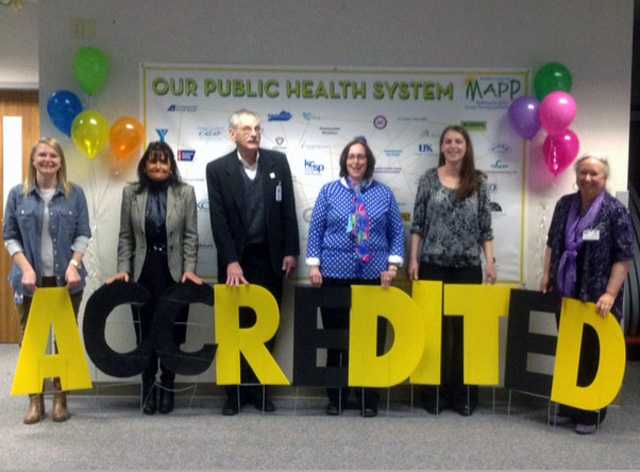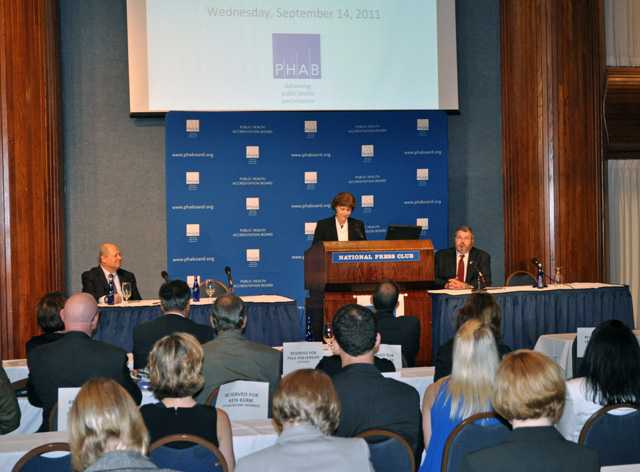America's First Nationally Accredited Health Departments
Spring 2013

CDC Director Tom Frieden with the health officials from the two accredited state health departments, Terry Cline, OK, and Mary Selecky, WA.

Staff from the Oklahoma State Department of Health celebrate their newly accredited status.

Local health officials and accreditation coordinators from the three accredited local health departments in Kentucky.

Judy Monroe speaking at the launch of accreditation on September 14, 2011 at the National Press Club. Also pictured: Jim Marks, MD, RWJF; Paul Halverson, DrPH, state health official, AR: and PHAB board of directors.
CDC plays key role in the establishment and support of the national accreditation program
On February 27, 2013, eleven health departments were awarded five-year accreditation by the Public Health Accreditation Board (PHAB), jointly supported by CDC and the Robert Wood Johnson Foundation (RWJF). These are the first-ever health departments to be nationally accredited.
“This is a truly historic moment in public health,” said PHAB President and CEO Kaye Bender. “With accreditation, we now have national standards that promote continuous quality improvement for public health and a mechanism for recognizing high performing public health departments. These are the first of many health departments that we look forward to being able to recognize for achieving national standards that foster efficiency and effectiveness, and promote continuous quality improvement.”
Accreditation status was awarded to
- Comanche County Health Department (Lawton, Oklahoma)
- Franklin County Health Department (Frankfort, Kentucky)
- Livingston County Department of Health (Mt. Morris, New York)
- Northern Kentucky Independent District Health Department (Edgewood, Kentucky)
- Oklahoma City-County Health Department (Oklahoma City, Oklahoma)
- Oklahoma State Department of Health (Oklahoma City, Oklahoma)
- Spokane Regional Health District (Spokane, Washington)
- The Public Health Authority of Cabarrus County, Inc. d/b/a Cabarrus Health Alliance (Kannapolis, North Carolina)
- Three Rivers District Health Department (Owenton, Kentucky)
- Washington State Department of Health (Olympia, Washington)
- West Allis Health Department (West Allis, Wisconsin)
A Big First for Public Health
National standards and accreditation programs have been established for other community services and organizations, such as schools, daycare centers, hospitals, and police departments. Until now, public health in the United States, on the other hand, has operated without a nationally accepted criterion for determining what constitutes a “good” health department.
National public health accreditation sets consistent standards against which the nation’s approximately 3,000 state, tribal, local, and territorial public health departments can continuously work to improve the quality of their services and performance. Accreditation by PHAB signifies that a health department is meeting those standards to provide essential public health services in the community.
To receive accreditation, a health department must undergo a rigorous, multifaceted, peer-reviewed assessment process to ensure it meets or exceeds a specific set of quality standards and measures. This assessment process provides valuable, measurable feedback to health departments on their strengths and areas for improvement. Standards address 12 domains of performance and span activities such as community health assessment, surveillance, investigation, health education, enforcement, policy development, emergency response planning, workforce development, quality improvement, and health department management and administration.
National accreditation is anticipated to transform public health. Not only does accreditation increase accountability and enhance credibility to stakeholders, partners, and communities, it also helps health departments better prepare to respond proactively to emerging and reemerging health challenges. In addition, accreditation can help maximize scarce resources by encouraging strategic investments to improve people’s health, demonstrate accountability to residents and elected officials, and spur innovation in meeting communities’ needs.
“Congratulations to the health departments that have achieved this extraordinary accomplishment,” said CDC Director Dr. Tom Frieden. “Just as schools, hospitals, and law enforcement agencies do, health departments can use the accreditation process to improve services and better protect health. We look forward to the day when most people in this country are served by accredited health departments.”
Dr. Frieden and Dr. Judy Monroe, director of CDC’s Office for State, Tribal, Local, and Territorial Support (OSTLTS) and deputy director of CDC, sent a congratulatory letter to each accredited health departments and will continue to send such letters to future accredited health departments.
Dr. Terry Cline, health commissioner for the Oklahoma State Department of Health, wanted his department to apply because he had been part of other systems that had been accredited, such as hospitals. “From my own experience . . . I was sold on the value of accreditation and saw it as being very good for the field and the discipline of public health. I was a believer from the beginning.”
Public health leaders and partners agree that this is big news for public health. PHAB, CDC, RWJF, and other major partners—including the Association of State and Territorial Health Officials and National Association of County and City Health Officials —have spread the word about this landmark in public health through media outlets, organizational newsletters, and social media. Within two weeks after its dissemination on March 4, 2013, the national press release had already garnered 30,809 headline impressions and been delivered to 10,270 media outlets, all the way from the Anchorage Daily News to the Miami Herald and even some overseas media outlets. Also, the Kentucky House of Representatives adopted House Resolution No. 148 on March 7, recognizing the national accreditation of the three Kentucky public health departments.
A Collaborative Effort
Since 2004, CDC and RWJF have partnered as funders, stakeholders, and supporters in the establishment of national accreditation, while other national public health organizations have played important roles on behalf of the constituencies to be accredited. Hundreds of local, tribal, state, and national public health leaders participated in the development and testing processes.
PHAB incorporated in 2007 to lead the effort and serve as the accrediting body. It was able to draw from experiences and lessons learned from accreditation in other sectors as well as existing standards and improvement initiatives in public health. The program was beta tested among 30 health departments in 2010 and formally launched on September 14, 2011.
OSTLTS serves as the agency’s nexus to foster awareness, engagement, and support of experts and leaders across all levels of public health. OSTLTS hosted a CDC-wide seminar on PHAB accreditation in 2012 and ensures that CDC expertise is included when PHAB focuses on such topics as preparedness, informatics, environmental health, and public health ethics. Accreditation readiness is also a strong focus of the OSTLTS National Public Health Improvement Initiative, which supports 73 state, tribal, local, and territorial health departments to advance their performance.
Hundreds of Health Departments Preparing
Within the first six months of the accreditation program’s launch, more than 70 health departments serving nearly 60 million Americans had formally applied to PHAB. Within 18 months, more than 125 departments had applied, including 30% of state health departments.
“We know that hundreds of health departments are preparing to apply and are working to address key activities in the standards,” said Liza Corso, senior advisor for public health practice and accreditation at OSTLTS. “Many health departments cite 2013 or 2014 dates for their application to PHAB, so the trajectory of accredited health departments is expected to really take off. Meanwhile, the standards are providing a strong focus for health department improvement efforts.”
Advancing Accreditation and Heading to the Future
Connections within CDC can advance how accreditation is woven into the culture of public health and programmatic support from CDC. For example, OSTLTS and CDC’s Office of Public Health Preparedness and Response have worked to identify the many direct and indirect connections between the PHAB standards and measures and the Public Health Emergency Preparedness target capabilities. Similar work has occurred to identify connections between PHAB standards and the evidence-based practices included within The Guide to Community Preventive Services.

Staff of the West Allis Health Department, WI, celebrating their newly accredited status.
“Linkages with our CDC programs and investments—such as the inclusion of PHAB within the new generic Funding Opportunity Announcement guidance—can reinforce the idea that accreditation readiness should strengthen a health department’s capacity to perform across many programs,” said Dr. Craig Thomas, director of OSTLTS’ Division of Public Health Performance Improvement.” “Likewise, CDC-supported programmatic activities can greatly contribute to meeting standards across all 12 PHAB domains.”
The true potential impact of accreditation is likely yet to be realized. “Successful organizations champion their mission and commit to continuous improvement. PHAB accreditation provides an unprecedented opportunity for the staff and leadership of health departments to pursue excellence,” said Dr.Monroe.
For more information, contact phaccreditation@cdc.gov or Liza Corso, Senior Advisor for Public Health Practice and Accreditation at OSTLTS.
- Page last reviewed: January 30, 2017
- Page last updated: January 30, 2017
- Content source:


 ShareCompartir
ShareCompartir



